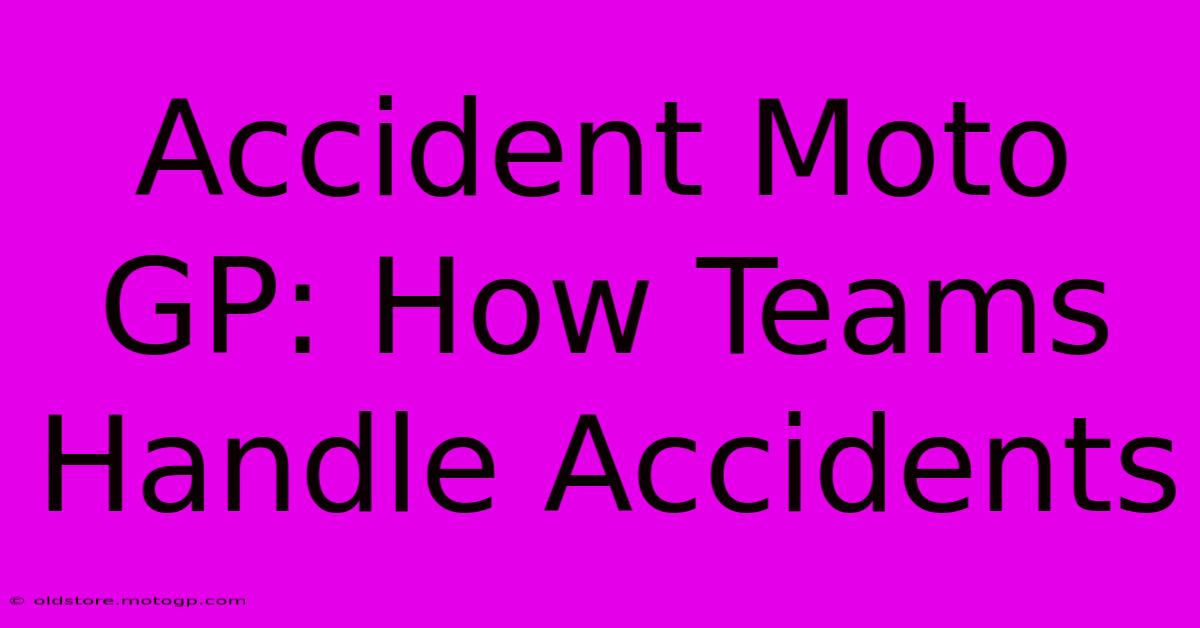Accident Moto GP: How Teams Handle Accidents

Table of Contents
Accident Moto GP: How Teams Handle Accidents
Motorcycle racing, particularly at the elite level of MotoGP, is inherently dangerous. High speeds, aggressive racing, and unforgiving tracks mean accidents are an unfortunate, but expected, part of the sport. However, the response to these accidents is incredibly sophisticated and crucial to rider safety and the team's continued performance. This article delves into how MotoGP teams handle accidents, from immediate response to long-term recovery.
Immediate Response: The Seconds That Matter
The immediate aftermath of a MotoGP accident is a whirlwind of activity. Speed and efficiency are paramount. Here's a breakdown of the critical steps:
1. Medical Intervention:
- Trackside Medical Team: The first responders are the highly trained medical professionals stationed at various points around the track. They are equipped to handle a wide range of injuries, from minor abrasions to severe trauma. Their primary goal is to stabilize the rider and ensure safe transport.
- Rapid Response: The speed of response is crucial. Ambulances are strategically placed, and medical personnel are ready to reach the scene almost instantly. Every second counts in minimizing potential damage.
- Initial Assessment & Treatment: A swift assessment is performed to identify the nature and severity of injuries. Immediate treatment is provided to address life-threatening conditions.
2. Recovery and Transport:
- Careful Extraction: If the rider is trapped under the motorcycle or otherwise difficult to access, specialized equipment and techniques are used for safe extraction, minimizing further injury.
- Transportation to Medical Center: The rider is carefully transported to a nearby medical center via ambulance or helicopter, depending on the severity of the injuries and the location of the accident.
3. Team Response:
- Communication: The team manager and crew chief are immediately notified. Communication lines are vital for coordinating efforts and relaying information to the rider's family and the media.
- Damage Assessment: The team assesses the damage to the motorcycle. This involves evaluating the extent of the damage to determine the feasibility of repairing the bike for the next race.
Post-Accident Analysis and Recovery
The immediate response is only the first phase. A comprehensive process follows to understand the accident and support the rider's recovery.
1. Accident Investigation:
- Data Analysis: Modern MotoGP bikes are equipped with extensive data logging systems. This data is crucial for analyzing the accident, identifying contributing factors, and improving safety measures.
- Track Inspection: The track is inspected to identify any potential track hazards that may have contributed to the accident.
- Rider Interview (When Possible): Once the rider is stable, they may be interviewed to provide their perspective on what happened.
2. Rider Rehabilitation and Support:
- Medical Care: Ongoing medical care is provided, including surgery, physiotherapy, and rehabilitation.
- Psychological Support: Accidents can have a significant psychological impact. Teams provide access to sports psychologists and other mental health professionals to help the rider cope with trauma and return to racing.
- Team Support: The team offers comprehensive support throughout the rider's recovery, both physically and emotionally.
3. Mechanical Repairs and Bike Upgrades:
- Motorcycle Repair: If repairable, the damaged bike is meticulously repaired. This process includes replacing damaged parts and conducting rigorous safety checks.
- Safety Improvements: Lessons learned from the accident are implemented to improve the bike's safety features. This might involve design modifications or improved safety protocols.
Conclusion: A Team Effort
Handling accidents in MotoGP is a complex and multifaceted endeavor. It's a testament to the dedication and professionalism of the medical teams, the racing teams, and the governing body (Dorna Sports) that riders are given the best possible care and support. The seamless coordination between these groups is vital for minimizing risk and ensuring the future safety of the riders. While accidents are an unavoidable part of the sport, the meticulous response and thorough post-accident analysis demonstrate a commitment to continuous improvement and rider welfare. This commitment is what ultimately keeps the sport thrilling while striving for enhanced safety.

Thank you for visiting our website wich cover about Accident Moto GP: How Teams Handle Accidents. We hope the information provided has been useful to you. Feel free to contact us if you have any questions or need further assistance. See you next time and dont miss to bookmark.
Featured Posts
-
Moto Gp Images Capturing The Essence Of Motorcycle Racing
Feb 23, 2025
-
Parking Near Cota This Austin Map Is Key
Feb 23, 2025
-
The Evolution Of Moto Gp Bikes And Their Impact On Wins
Feb 23, 2025
-
Find The Perfect Racing Gift Circuit Of The Americas Store
Feb 23, 2025
-
The Definitive Guide To F1 Us Grand Prix Tv Coverage 2023
Feb 23, 2025
